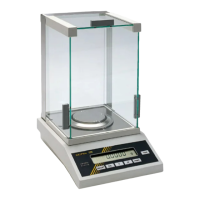
Do you have a question about the KERN 770-12 and is the answer not in the manual?
Provides guidance on optimal environmental settings for balance accuracy and longevity.
Details on assembling the weighing chamber components for different balance models.
Instructions for safely connecting the balance to a power source using the AC adapter.
Essential safety measures to follow when operating the balance and connecting peripherals.
Specifies the minimum warm-up period required for accurate results after power connection or outage.
Describes the procedure for powering the balance on, off, or placing it in standby mode.
Explains the automatic self-test sequence performed when the balance is powered on.
Details on how to zero the weight display to determine net weight accurately.
Procedure for determining the weight of a sample placed on the weighing pan.
Steps for calibrating the balance using its built-in adjusting weight.
Procedure for calibrating the balance using an external adjusting weight.
How to disable the balance's adjusting and calibration functions via menu code.
Steps for safely cleaning the balance using mild detergents and appropriate tools.
Guidelines for performing safety checks on the balance and its AC adapter.
Instructions on how to navigate and modify settings within the balance's operating menu.
Detailed steps to enter and navigate the balance's operating menu system.
Procedure to revert all menu code settings back to their original factory defaults.
Configuring the balance to match prevailing environmental conditions for optimal performance.
Settings for standard operation versus manual filling mode for compensation of fluctuations.
Adjusting the criteria for the stability symbol to remain displayed based on weight variation.
Defining when the balance performs the taring operation, either anytime or after stability.
Enabling or disabling the automatic taring of minor zero point changes.
Overview of menu codes for activating external/internal adjusting and linearisation.
Guide to selecting and converting between various weight units using the F key.
Setting the data transmission speed (baud rate) for the interface.
Configuring the parity bit for data transmission (Mark, Space, Odd, Even).
Setting the number of stop bits for data transmission (1 or 2).
Defining the handshake protocol (software or hardware) for data communication.
Configuring data output based on stability or print requests.
Controlling automatic data output, including stopping and starting the function.
Setting intervals for automatic data output based on display updates.
Enabling automatic taring after data output for sequential weighing.
Using ID codes to identify different types of data output, such as net weights.
Selecting values from tare memory for automatic output.
Functionality to store tare weights for subsequent use and identify stored values.
Demonstrates weighing multiple components and calculating their total net weight.
Application for obtaining weight readouts as a percentage of a reference weight.
Step-by-step guide for determining residual weight in percent, often for moisture analysis.
Function for converting weights into piece counts based on a reference sample weight.
Illustrates how to count bulk quantities of items with the same weight.
Program for weighing living animals or under unstable conditions using averaging.
Configuring delayed start criteria for averaging based on sub-weight differences.
Adjusting the count of individual weighings used for the averaging calculation.
Demonstrates weighing animals using the automatic start mode with averaging.
Illustrates weighing animals using the manual start mode with averaging.
Procedure for obtaining a compliant data record, including printout headings and data.
Including reference data in printouts for application programs like counting.
Introduction to the balance's RS 232 C interface for connecting external devices.
Notes on electrical connections and potential interference when connecting devices.
Technical details of the interface, including type, mode, standard, and transmission rates.
Details on the structure and content of data transmitted from the balance, with or without ID codes.
Explanation of status and error codes outputted by the balance during data transmission.
List and function of control commands using upper-case letters or special characters.
List and function of control commands using lower-case letters.
Methods to activate data output, either automatically or via print command.
Configuration for 'auto print' mode, including output at defined intervals or stability.
Visual representation of the wiring diagram for interfacing computers or peripherals.
